What Year and Model is my Golf Cart?
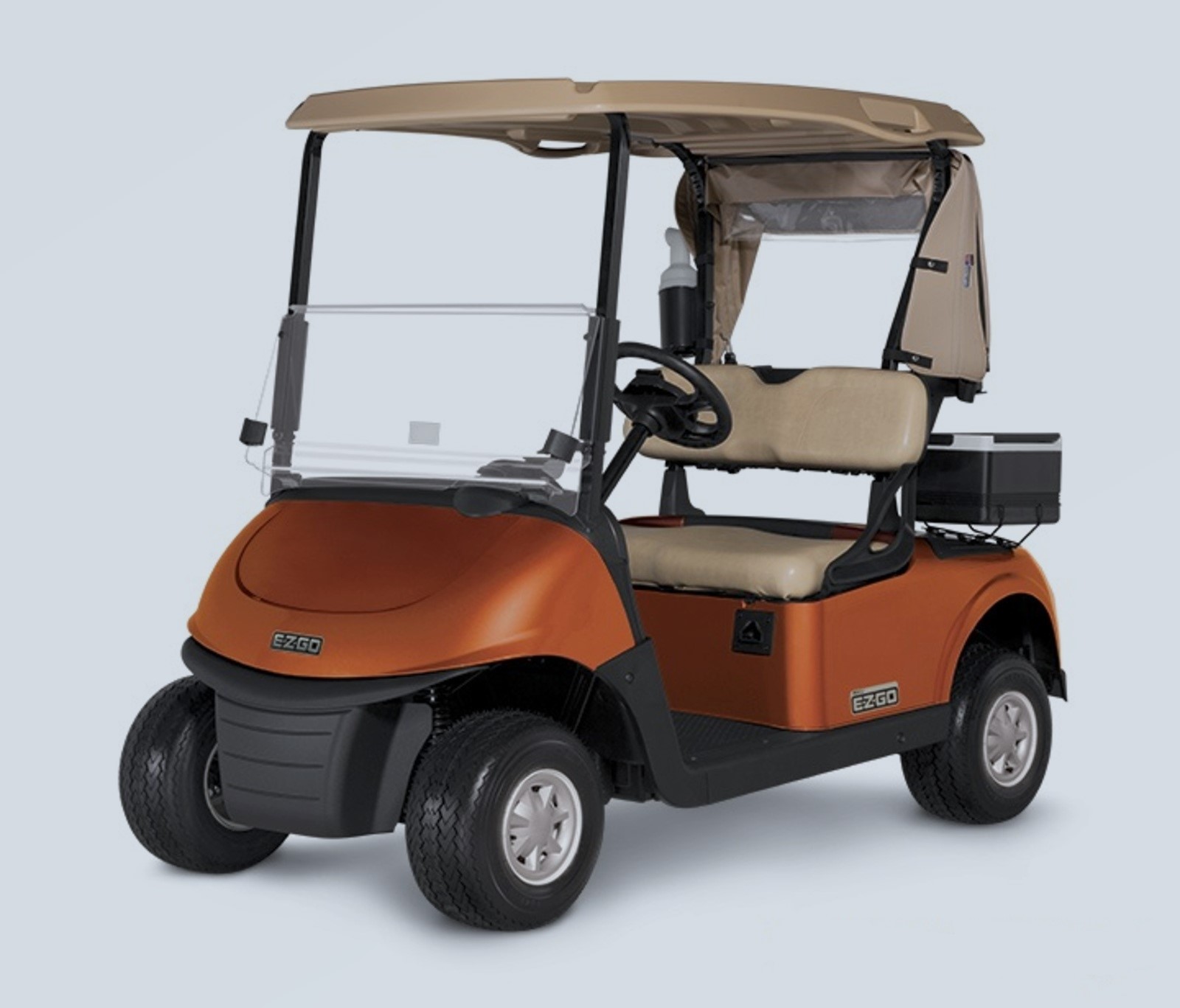
When sourcing golf cart parts and accessories, or servicing your cart, it is helpful to know the brand or make of your golf cart. Within each make of golf cart, there are different models and then the year of manufacture that needs to be considered. See our guide below for the most common golf cart makes to assist you in determining this information.
GOLF CART YEAR AND MODEL GUIDES
WHAT YEAR AND MODEL IS MY EZGO GOLF CART?

EZGO serial numbers do not indicate the year of production. You will need the Model/ Manufacturer number to determine the year of an EZGO. Below is a basic model number guide.
EZGO MARATHON was made in the years 1975 – 1993.
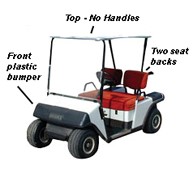
The model and serial numbers can be found on the plate located under the passenger side glove compartment. The manufacturer number will have 1 letter followed by 3 or 4 numbers. Two of the grouped numbers will indicate the year of production. Features include:
- Two separate seat backs
- Front plastic bumper
- Black plastic nose cap
- No Top Handles
EZGO MEDALIST was made in the years 1993 – 1999.
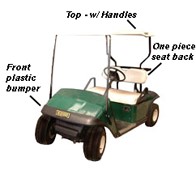
The serial number is located on a plate located inside the passenger side glove compartment. The manufacturer number will have 1 letter followed by 3 or 4 numbers. Two of the grouped numbers will indicate the year of production. Features include:
- Connected seat back
- Plastic Front Bumper
- Top with Handles
EZGO TXT was made in the years 1996 - present.
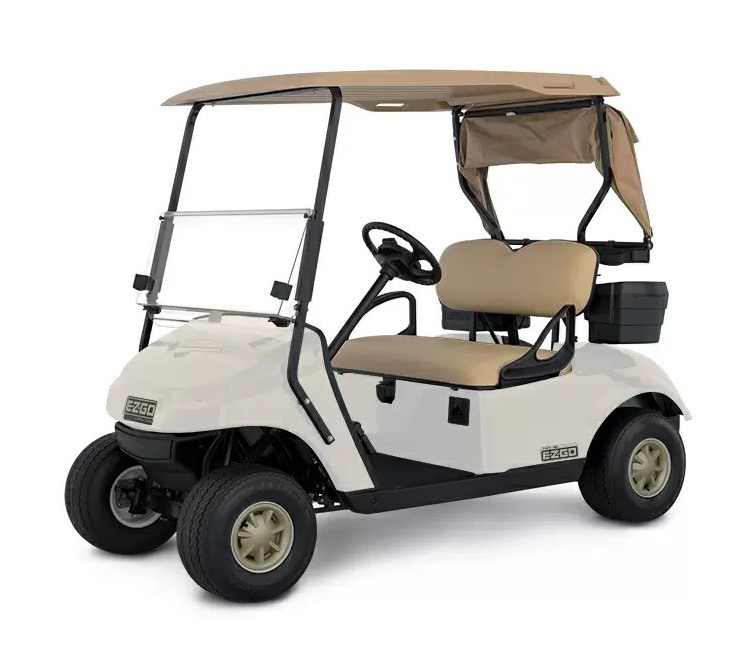
The serial number is located on a plate inside the passenger side glove compartment. The manufacturer number will have 1 letter followed by 3 or 4 numbers. Two of the grouped numbers will indicate the year of production. Features include:
- Connected seat back
- Small Plastic Front Bumper
- Top with Handles
EZGO RXV was made in the years 2008 – present.
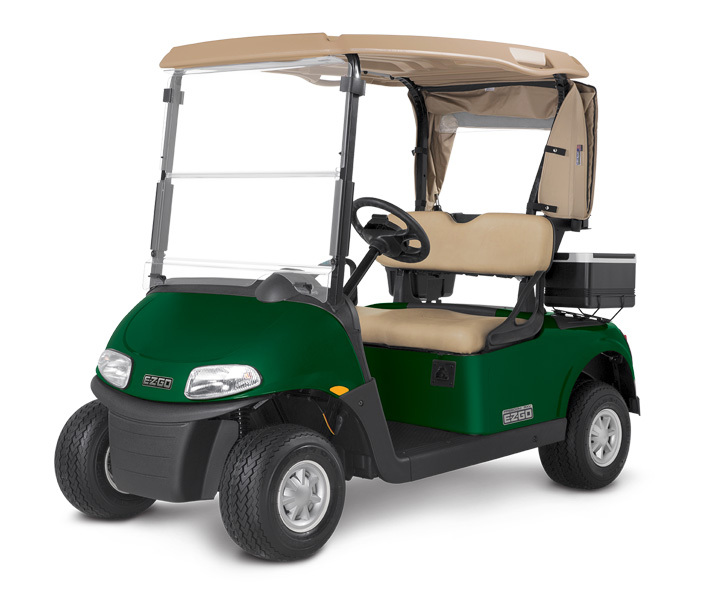
The serial number is located in 3 different places. One is placed on the base of the steering column, the 2nd is located on the frame under the front splash shield on the driver’s side, and the 3rd is located on the passenger side frame rail at the rear of the cart. Features include:
- Connected seat back
- Rounded front fenders with large bumper on front
- Moulded plastic roof with handles.
EZGO RXV REFRESH models were made in the years 2015 – present. It will also look like the golf cart pictured above., however the rear rubber steps will be smaller in design.
EZGO RXV ELiTE was introduced in 2017 - The FIRST lithium battery cart.
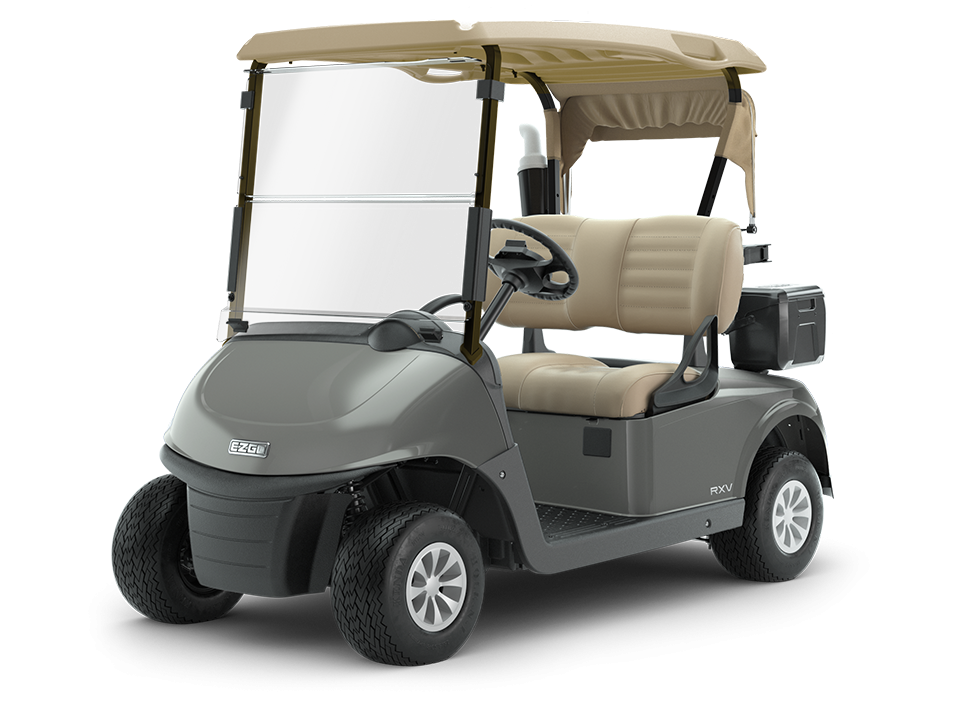
The serial number is located in 3 different places. One is placed on the base of the steering column, the 2nd is located on the frame under the front splash shield on the driver’s side, and the 3rd is located on the passenger side frame rail at the rear of the cart and also features:
- Connected seat back
- Rounded front fenders with large bumper on front
- Moulded plastic roof with handles.
EZGO 2FIVE was made in 2009 to present.

Features include:
- Glass Windscreen
- Windscreen wiper
- 3–Point Seat Belts
- Turn Signals - indicators
- Headlights and tail lights
- Rear View Mirrors
EZGO WORKHORSE was made in 1996-2003.

Features include:
- Square-shaped front nose
- Single rectangular seat back
- 54" top with handles
- Non lifted
- Dual headlights
- Cargo Bed or Box on rear.
EZGO ST began production in 1999.

Features include:
- Square shaped front nose with two light holes
- Single seat back
- 54" top with handles
- Lifted vehicles with 20' tyres or larger
EZGO MPT began production in 2004.

Features include:
- Square shaped front nose with two light holes
- Single rectangular seat back
- 54" top with handles
- Non lifted
- Double headlights
- Cargo bed or box on the rear
EZGO EXPRESS began production in 2012.

Features include:
- Sloped front cowl
- Dual headlights horizontal tail lights
- Factory front brush guard
- Factory-installed rear seat kit
- Extended top
WHAT YEAR AND MODEL IS MY CLUB CAR GOLF CART?

Club Car serial numbers indicate the model and year of production.
- The first 1 or 2 letters determines the Model - see table below
- The next 2 numbers determine the Year
- The next set identifies the week of production.
Below is the first letter that would be associated with the model.
| A |
DS Electric Golf Car |
| AA |
DS Electric Golf Car, 48 Volt |
| AB |
DS Electric Golf Car, 36 Volt |
| AC |
DS Electric Golf Car, 48 Volt Regen |
| AQ |
DS Electric IQ 48 Volt Regen |
| AG |
DS Gasoline/Petrol Golf Car |
| PG |
Precedent Gasoline/Petrol Golf Car |
| PQ |
Precedent Electric IQ 48 Volt Golf Car |
For example:
AQ0746-123456 =
DS 2007 Model
Use the details and pictures below to find where your serial number is located.
CLUB CAR DS was made in the years 1982 - 2000.5.

The serial number can be found just under the passenger side glove box and features:
- Two separate seat backs
- Uses a rubber coated pipe as seat armrests
- Silver aluminium roof supports
- Thin plastic roof with no handles
CLUB CAR DS [2000.5] was made in the years 2000.5 - present.

The serial number located on a sticker located just behind the accelerator pedal mounted to the frame and features:
- Connected seat back
- Moulded plastic triangular shaped arm rests
- Black roof supports
- Moulded plastic roof with handles
- Serial Number located on a sticker located just behind the accelerator pedal mounted to the frame.
CLUB CAR PRECEDENT were introduced in 2004.

The serial number is located on a sticker inside the passenger side glove compartment or just under the passenger side glove compartment on the kick panel and also features:
- 360 Degree Wrap Around Bumper
- Moulded plastic rear roof supports
CLUB CAR TEMPO was introduced in 2018.

The serial number is located on a sticker inside the passenger side glove compartment or just under the passenger side glove compartment on the kick panel and also features:
- Connected back
- Square front nose cone
- Premium comfort seats
- Dashboard upgrade

WHAT YEAR AND MODEL IS MY YAMAHA GOLF CART?

Yamaha serial numbers will indicate the model, engine type and year of production.
Below is a basic serial number guide for each model.
YAMAHA G1 began production in 1979.

The serial number is located near the driver’s side rear tyre underneath the golf cart.
| G1 – PETROL |
G1 – ELECTRIC |
| J10-000101 |
1979 |
J14-000101 |
1980 |
| J10-007705 |
1980 |
J14-100101 |
1981 |
| J10-030101 |
1981 |
J22-000101 |
1982 |
| J17-000101 |
1982 |
J26-000101 |
1983 |
| J24-000101 |
1983 |
J36-000101 |
1984 |
| J31-000101 |
1984 |
J36-010101 |
1985 |
| J31-100101 |
1985 |
J36-011212 |
1986 |
| J31-140101 |
1986 |
J31-159082 |
1989 |
YAMAHA G2 began production in 1985.
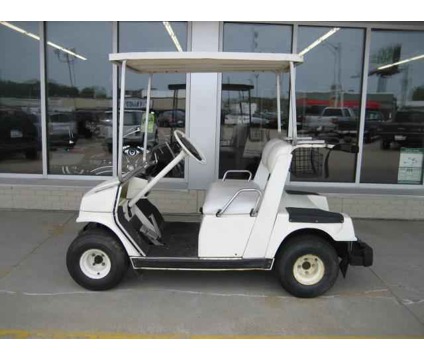
The serial number can be located in one of two places. Either under the seat towards the front of the golf cart, or under the front bumper on the frame of the golf cart.
| G2 – PETROL |
G2 – ELECTRIC |
| J38-000101 |
1985 |
J41-000101 |
1985 |
| J10-007705 |
1986 |
J41-016101 |
1986 |
| J38-020101 |
1987 |
J41-030101 |
1987 |
| J38-071101 |
1988 |
J41-053101 |
1988 |
| JA2-000001 |
1988 |
JE2-000001 |
1988 |
| J55-000101 |
1989 |
J56-000101 |
1989 |
| J55-100120 |
1990 |
J56-100101 |
1990 |
| J55-200101 |
1991 |
J56-200101 |
1991 |
YAMAHA G3 began production in 1986.

Serial numbers are located near the passenger side rear tyre underneath the golf cart.
| G3 – PETROL |
G3 – ELECTRIC |
| J42-000101 |
1986 |
J46-000101 |
1987 |
YAMAHA G5 began production in 1990.
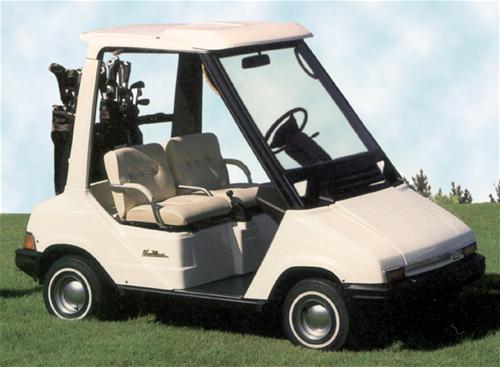
The Yamaha G5 was introduced in 1990. The serial number can be located underneath the front bumper area on the frame.
| G5 – PETROL |
G5– ELECTRIC |
| J50-000101 |
1990 |
J51-000101 |
1990 |
| J50-100101 |
1991 |
J51-100101 |
1991 |
| J50-200103 |
1992 |
J51-200101 |
1992 |
| J50-300101 |
1993 |
J50-400101 |
1994 |
| J50-500101 |
1995 |
|
|
YAMAHA G8 began production in 1990.
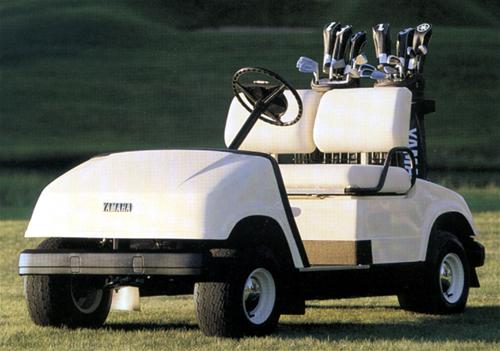
The Yamaha G8 serial number is located under the passenger side seat towards the front of the golf cart.
| G8 – PETROL |
G8 – ELECTRIC |
| JF2-000007 |
1990 |
JF3-000005 |
1990 |
| JF2-100101 |
1991 |
JF3-100101 |
1991 |
| JF2-200101 |
1992 |
JF3-200101 |
1992 |
| JF2-30010 |
1993 |
JF3-300101 |
1993 |
| JF2-400101 |
1994 |
JF3-400101 |
1994 |
| JF3-401801 |
1994 |
JF3-402000 |
1995 |
YAMAHA G9 began production in 1991.

Yamaha G9 serial numbers are located underneath the seat towards the front of the golf cart.
| G9 – PETROL |
G9 – ELECTRIC |
| JG5-000101 |
1991 |
JG6-000001 |
1991 |
| JG5-100101 |
1992 |
JG6-100101 |
1992 |
| JG5-200103 |
1993 |
JH7-000125 |
1992 |
| JG5-300101 |
1994 |
JH7-100101 |
1993 |
| JG5-400101 |
1995 |
JH7-200149 |
1994 |
| |
|
JH7-300101 |
1995 |
YAMAHA G11 began production in 1993.
Serial number is located underneath the seat towards the rear of the golf cart.
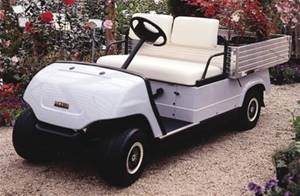
| G11 - PETROL |
| JJ3-000101 |
1993 |
| JJ3-100101 |
1994 |
| JJ3-200101 |
1996 |
| JR3-000101 |
1997 |
| JR3-100101 |
1998 |
| JR3-200101 |
1999 |
| JR3-300101 |
2000 |
YAMAHA G14 & G16 began production in 1995.
Serial numbers are located underneath the driver’s side seat towards the front of the golf cart. Some models may have the serial number located inside the driver’s side glove compartment as well.
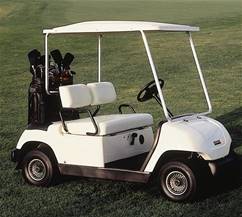
| G14 - PETROL |
G14 – ELECTRIC |
| JN3-100101 |
1995 |
JN4-100101 |
1995 |
| JN3-200101 |
1996 |
JN4-200101 |
1996 |
| G16 - PETROL |
G16 - ELECTRIC |
| JN6-000101 |
1996 |
JN8-000101 |
1996 |
| JN6-100101 |
1997 |
JN8-100101 |
1997 |
| JN6-200101 |
1998 |
JN8-200101 |
1998 |
| JN6-300101 |
1999 |
JN8-300101 |
1999 |
| JN6-400101 |
2000 |
JN8-400101 |
2000 |
YAMAHA G19-G21 began production in 1996.
The serial number is located inside the driver’s side glove compartment or under the rear bumper attached to the frame.
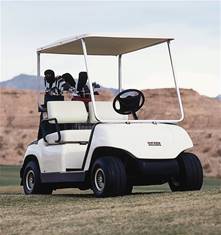
| G20 - PETROL |
G19 - ELECTRIC |
| JR8-000101 |
2000 |
JR1-000101 |
1996 |
| JR8-100101 |
2001 |
JR1-100101 |
1997 |
| JR8-200101 |
2002 |
JR1-200101 |
1998 |
| G21 - PETROL |
JR1-300101 |
1999 |
| JR6-000101 |
2001 |
JR1-400101 |
2000 |
| JR6-100101 |
2002 |
JR1-500101 |
2001 |
| JR6-200101 |
2003 |
JRI-600101 |
2002 |
| JR6-300101 |
2004 |
YAMAHA G22 (G-MAX) began production in 2003.

The serial number is located inside the driver’s side glove compartment.
| G22 - PETROL
(G-MAX)
|
G22 - ELECTRIC
(G-MAX) |
| JU0-000101 |
2003 |
JU2-000101 |
2003 |
| JU0-100101 |
2004 |
JU2-100101 |
2004 |
| JU0-200101 |
2005 |
JU2-200101 |
2005 |
| JU0-209201 |
2005 |
JU2-205701 |
2005 |
| JU0-300101 |
2006 |
JU2-300101 |
2006 |
| JU0-310101 |
2006 |
JU2-306201 |
2006 |
| JU0-400101 |
2007 |
JU2-400101 |
2007 |
YAMAHA G29 (YDR DRIVE) began production in 2007.
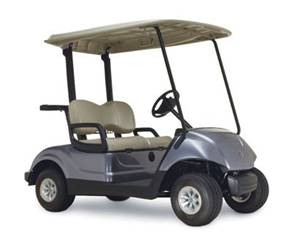
Their serial number is located on the passenger side near the seat from 2007-2010. In 2011 and up the serial number is located underneath the seat towards the rear of the golf cart.
G29 – PETROL
(YDR DRIVE) |
G29 – ELECTRIC
(YDR DRIVE) |
| JW1-000101 |
2007 |
JW2-000101 |
2007 |
| JW1-100101 |
2008 |
JW2-100101 |
2008 |
| JW1-200101 |
2009 |
JW2-200101 |
2009 |
| JW1-300101 |
2010 |
JW2-300101 |
2010 |
| JW8-000101 |
2011 |
JW9-000101 |
2011 |
| JW8-100101 |
2012 |
JW9-100101 |
2012 |
| JW8-200101 |
2012.5 |
JW9-200101 |
2012.5 |
When should Batteries be replaced?
HOW LONG DO GOLF CART BATTERIES LAST?
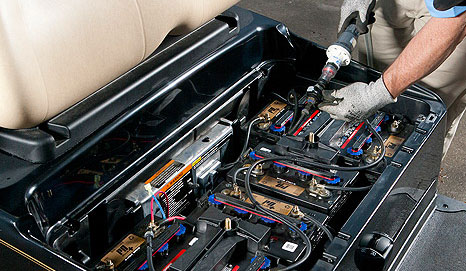
At East Coast Carts, we get this question all the time. Unfortunately, it is one of the hardest to answer. The correct answer is: “It all depends on how you take care of them.” Why is this? Well, deep cycle battery packs require some basic maintenance which includes maintaining the correct electrolyte (water) levels while ensuring the battery pack is fully charged and never left in a discharged state (plugging it in after each use or round of golf).
Aside from maintenance practices affecting the life span of golf cart batteries, usage becomes the next biggest factor. Battery packs in golf course fleet applications get much higher usage on average than a golf cart owned by a private owner. Fleet carts get used for 2-3 rounds of golf per day during the peak seasons while private carts tend to be 3-5 rounds of golf per week (sometimes more depending on the number of golfers using the cart). That all being said, properly maintained battery packs in fleet carts tend to last about 4-6 years while private owners tend to get about 6-10 years out of their battery packs.
Other major factors include the type of options on the cart that may increase the draw from the battery pack. Options such as headlights and taillights or an optional top speed code can really affect the overall range, life span and performance of deep cycle golf cart batteries.
If you live on or near the golf course in a golf course community and drive to and from the golf course, this also greatly affects the battery pack. In some instances, driving to the golf course, doing the round of golf, and then driving home is the equivalent to 2-3 rounds of golf for a fleet cart. Owners who use their cart in this manner tend to see shorter battery life spans.
HOW DO I KNOW WHEN IT IS TIME TO CHANGE THEM?
Golf cart batteries are more powerful than ever. They allow you to roam freely regardless of terrain, listen to your music, and enjoy better lighting irrespective of the time of day.
However, all batteries must be replaced eventually. Astute golf cart owners will be able to notice the signs of a failing battery. Sometimes, though, the symptoms aren’t so simple.
Review the following situations carefully and if you notice your golf cart has any of these issues, it may be time to replace your batteries.
Small Hills Become a Challenge
Golf carts are not designed for climbing mountains, but they should be able to handle smaller hills and slopes. If you notice your golf cart struggling to make it up an incline, it could be a sign the cart is not getting enough power.
Pay attention to changes in the way the cart handles to pick up on this issue. You might find that you have to push the accelerator pedal all the way down to the floor for it to go on non-flat surfaces. As you crest the hill, the golf cart might start coasting due to a loss of power. If you notice any of these signs, as well as other apparent indicators that your cart is not getting enough power, replace your golf cart battery immediately. Doing so will prevent you from getting stuck in precarious situations or getting stranded too far from help.
The Cart Takes Far Too Long to Charge
A standard golf cart battery in optimum condition can take a full night to completely charge. Any longer than this means your cart will soon need a new battery.
Rechargeable batteries have become pillars of modern convenience. Certainly, they’ve changed the way we keep ourselves entertained, the way we work, and the way we transport ourselves. However, the reality is that rechargeable batteries are constantly being drained and charged. The chemicals in the battery only last so long through these cycles. Therefore, all rechargeable batteries will eventually need to be changed out.
Diminished Range
You should be able to travel several miles in your golf cart before you need to charge it again. In other words, a full battery charge easily tackles a trip around the golf course or through the neighbourhood. There’s nothing worse than your game or joyride being interrupted by a dead battery, which happens as the battery’s charging capacity declines. If you’re nine holes in and your battery starts getting weak, then you’ll want to check it.
Delayed Acceleration and Loss of Top Speed
Today’s golf carts are designed with advanced technology, which allows them to be comfortable and responsive to your “command.” When you command speed by pressing your foot on the accelerator, you should feel it respond almost instantly. The longer it takes to respond, the more likely it is that it’s time to look at a new golf cart battery. Additionally, if you notice your top speed has reduced since you purchased your golf cart, this could also be a sign of an old and/or failing battery. Have your golf cart checked by your trusted technician to determine whether it is the battery or another acceleration component. Then, replace them accordingly.
Braking is Not Responsive
Losing acceleration and top speed is frustrating. For the most part, it means you will get to your final destination later than you expected. However, losing braking can be much more dangerous than that, and it is a possibility if your battery isn’t functioning well. Golf cart brakes should be a priority for all golf cart owners. Once they stop responding, they instantly put you and others at risk. At the first sign of brake issues, ensure the golf cart is looked at. If the braking problem is determined to be caused by your battery, visit East Coast Carts to purchase a new golf cart battery.
Accessories Acting Up
Keep an eye on your golf cart accessories. If your battery is failing, your accessories will start failing or cutting out with more frequency. This includes your sound system, interior lighting, air conditioning, and more. You may have had all of these running at the same time with zero issues in the past. But each use drains the battery a little more, and it can add up over time.
Physical Battery Issues
Many of the signs above are gradual, meaning it might be hard to notice them immediately. However, the most serious indicators of a battery that is failing are physical and visible flaws. These include:
Bulging, Expansion, and Cracks:
If your battery’s housing is distorted, cracked, or bulging in any way, that means the internal components of your battery are having significant issues. Your battery’s cells likely won’t charge up all the way or even hold a charge. Worse, a bulging battery could cause physical harm. Always replace the battery at the first sign of bulging, expansion, or cracks.
Leaks or Corrosion:
Battery corrosion is an irritating but frequent issue that all batteries face. Unfortunately, even a small bump along your journey can cause shortages of power due to corrosion. Cleaning your battery can often take care of the corrosion problem. Unfortunately, even with a good cleaning, the corrosion will typically worsen over time. When corrosion becomes frequent and hard to keep under control, you likely need a new battery. The same goes for leaks. Batteries that leak acid are an environmental and safety hazard and need to be disposed of properly and replaced immediately.
DON'T NEGLECT YOUR BATTERIES
They are the powerhouse that allows you to accelerate, brake, and enjoy your favourite accessories. Consider the warning signs above and order replacement batteries if you notice any of them.
Depending on the make, model and age of your cart, you could also give consideration to upgrading your batteries to maintenance free Lithium Batteries.